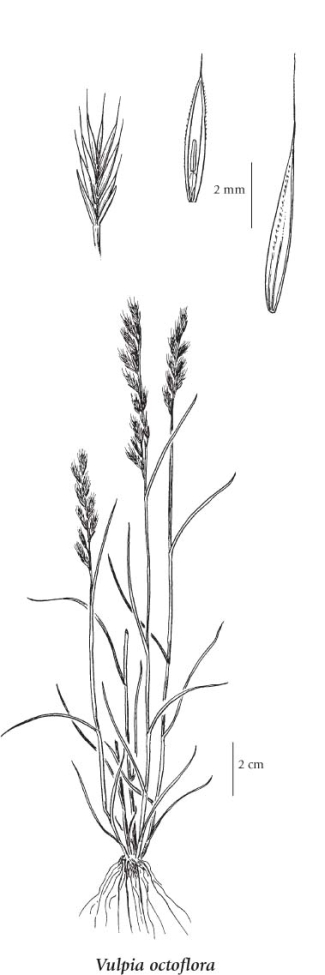Vulpia octoflora var. octoflora (Walter) Rydb.
six-weeks grass (sixweeks fescue; six-weeks fescue)
Poaceae (Grass family)
Introduction to Vascular Plants
six-weeks grass (sixweeks fescue; six-weeks fescue)
Poaceae (Grass family)
Introduction to Vascular Plants
Species Information
General:
Annual, loosely tufted grass from fibrous roots; stems sometimes solitary, erect (sometimes bent or angled at the lower nodes), (3) 6-30 (60) cm tall.
Leaves:
Sheaths smooth or the lower ones usually short-hairy with the hairs directed downward; blades flat or rolled, smooth or short-hairy, to 1 mm wide; ligules 0.2-0.7 mm long.
Flowers:
Inflorescence a narrowly erect panicle (sometimes reduced to a raceme), (1) 2-7 (20) cm long; spikelets 4-10 mm long (excluding the awns), 5- to 11- (17-) flowered, the florets closely overlapping; glumes smooth or short-hairy, the lower glumes 1- to 3-nerved, (1.7) 2-4.5 mm long, the upper glumes 3-nerved, (2.7) 3.5-5.5 (6.7) mm long; lemmas smooth or short-hairy, lanceolate, 2.7-5 (6.5) mm long, the terminal awns (0.3) 1.5-4.5 (9) mm long; rachilla internodes usually 0.5-0.7 mm long; anthers 1 (rarely 2 or 3), (0.3) 1-3.3 mm long.
Notes:
Three poorly separated varieties are sometimes recognized on the basis of floret size and hairiness. All of these phases can be found in BC.
Illustration

If more than one illustration is available for a species (e.g., separate illustrations were provided for two subspecies) then links to the separate images will be provided below. Note that individual subspecies or varietal illustrations are not always available.
Illustration Source: The Illustrated Flora of British Columbia
Ecology
Ecological Framework for Vulpia octoflora
The table below shows the species-specific information calculated from
original data (BEC database) provided by the BC Ministry of Forests and Range.
(Updated August, 2013)
The table below shows the species-specific information calculated from
original data (BEC database) provided by the BC Ministry of Forests and Range.
(Updated August, 2013)
| Site Information |
Value / Class |
||
|
Avg |
Min |
Max |
|
| Elevation
(metres) |
600 | 87 | 2005 |
| Slope
Gradient (%) |
25 | 0 | 360 |
|
Aspect (degrees) |
190 | 5 | 360 |
| Soil
Moisture Regime (SMR) [0 - very xeric; 4 - mesic; 8 - hydric] |
2 | 0 | 7 |
| Modal
Nutrient Regime
Class |
C | ||
| #
of field plots species was recorded in: |
277 | ||
| Modal
BEC Zone Class |
BG | ||
|
All BEC Zones (# of stations/zone) species was recorded in |
BG(156), CWH(1), ESSF(1), ICH(7), IDF(35), PP(63) | ||
|
Source:
Klinkenberg 2013
|
|||
Habitat and Range
Mesic to dry slopes and plains, open forests, roadsides and disturbed areas in the lowland and montane zones; frequent in SC and SE BC; E to PQ and NB and S to ME, MA, PA, NC, FL, MS, LA, TX, NM, AZ, CA and MX.Status Information
Synonyms
Synonyms and Alternate Names:
Vulpia octoflora var. glauca (Nutt.) Fernald
Vulpia octoflora var. hirtella (Piper) Henr.
Vulpia octoflora var. octoflora (Walter) Rydb.